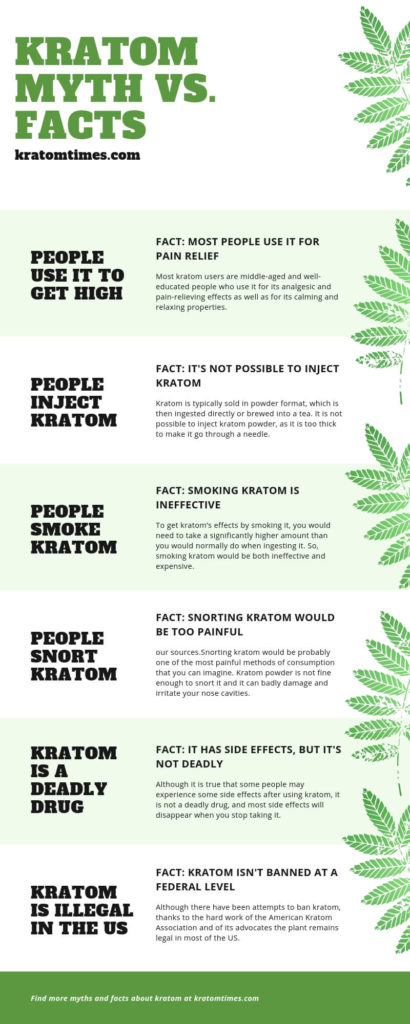Back in 2016, the DEA announced its intentionality to ban kratom. But thanks to the efforts of the kratom advocates, who started sending out letters to their political representatives, and voicing the way kratom has helped them, this move was stopped. However, recently, the FDA has started a process to try and make kratom illegal in the US. At the moment, it is uncertain what the future holds for kratom and for kratom users and vendors.
But why is the FDA trying to criminalize kratom? There have been claims that kratom is a deadly opiate drug and that it has provoked salmonella poisonings among its users. That’s why many people think that kratom is the same as drugs such as heroin or crack. In this article, we’ll try to give an overview of some kratom myths and see if they are or not true.
What Is Kratom?
Native to the islands of South East Asia, kratom is a very popular herb in the areas where it grows. In fact, the inhabitants of these regions have traditionally used the plant for centuries for its energizing and stimulating properties, as well as a natural analgesic.
The plant is a tall tree that belongs to the Rubiaceae family, which is, in fact, the same as the coffee tree. And, like coffee, it owes its properties to the high number of components that are present in its leaves. The two main kratom alkaloids are Mitragynine and 7-Hydroxymitragynine, which are responsible for most of kratom’s effects.
Why Has Kratom Become Popular?
Although it is relatively new in the Western countries, kratom’s popularity is increasing day after day. The reason for this is that many users claim that the substance has helped them mitigate and ease several conditions. In fact, many users claim that thanks to kratom they have been able to alleviate chronic pain so much, that now they’re able to lead a normal life again (which they couldn’t before taking kratom). But the plant has some other properties, including:
- Stimulating
- Energizing
- Analgesic
- Calming and relaxing
Thanks to the above properties, kratom users take the plant to mitigate conditions such as chronic pain, anxiety, insomnia and to relieve opiate withdrawal symptoms, to name a few. Additionally, thanks to its energizing properties, many take it to help them go through hard working days.
Kratom Myths Vs. Facts
Although many news sites, blogs, and media have recently discovered and started talking about kratom, there is still a lot of misinformation about the plant. Below we’ll give you an overview of the most popular kratom myths and see what the reality is.

People Use Kratom to Get High
Despite what many people think, typical kratom users are not young people that are looking to get high. Although it is true that it has stimulant properties, most kratom users are middle-aged and well-educated people who use it for other reasons. Especially, many individuals use it for its analgesic and pain-relieving effects. Many others use it for its calming and relaxing properties. Some of the most common kratom users are people who suffer from chronic pain conditions, such as back pain or fibromyalgia. Also, many people who suffer from PTSD or anxiety take kratom to feel more at ease. Additionally, other people who take kratom are professionals who have to face hard working days or people who suffer from social anxiety.
People Inject Kratom
Injecting kratom is something that makes no sense at all. Kratom is typically sold in powder format, which is then ingested directly or brewed into a tea. It is not possible to inject kratom powder, as it is too thick to make it go through a needle.
People Smoke Kratom
Although technically kratom can be smoked, consumers won’t find this an option to take it. The reason for this is that the best way to feel its properties is by the absorption of its alkaloids through the bloodstream. So, in order to get kratom’s effects by smoking it, you would need to take a significantly higher amount than you would normally do when ingesting it. So, smoking kratom would be both ineffective and expensive.
People Snort Kratom
Like smoking kratom, you can technically snort kratom. But just like we mentioned above, in order to feel its effects kratom must be absorbed by the system through the bloodstream. So, you would need high amounts of powder to experience any effects at all. Additionally, snorting kratom would be probably one of the most painful methods of consumption that you can imagine. Kratom powder is not fine enough to snort it and it can badly damage and irritate your nose cavities.
Kratom Is a Deadly Drug
This is probably the most controversial argument that many uses when talking against kratom. The FDA has claimed that, recently, dozens of people have died after using kratom. But these kratom death claims have been proven wrong. Although it is true that some people may experience some side effects after using kratom, it is not a deadly drug, and most side effects will disappear when you stop taking it.
Kratom Is Illegal
Although there have been attempts to ban kratom, thanks to the hard work of the American Kratom Association and of its advocates the plant remains legal in the US. Nevertheless, there are some states and cities where it has been banned. So, if you plan to take kratom, do a research to learn if it’s legal where you live.
Kratom Has No Medical Value
There are many claims that state that kratom has none or too little medical value. But there are many studies that prove to the contrary. Most of these studies show the potential benefits of the plant in conditions such as anxiety and pain. Additionally, some studies show its potential as a substitute for opioids.
Kratom Is an Opioid
Although the FDA has called kratom an opioid, this is not entirely true. Although kratom acts by binding to the mu opioid receptors of the brain, it doesn’t have one of the most dangerous opioid side effects, which is respiratory depression. Additionally, kratom researchers have said that the method that the FDA used to declare kratom an opioid is not at all accurate.
Finally remember that if you are new to kratom and want to give it a go, you should research to find which variety is better for you.


